Blister Beetle Larvae on Native Bees - Triungula!
Blister Beetle triungula on bees
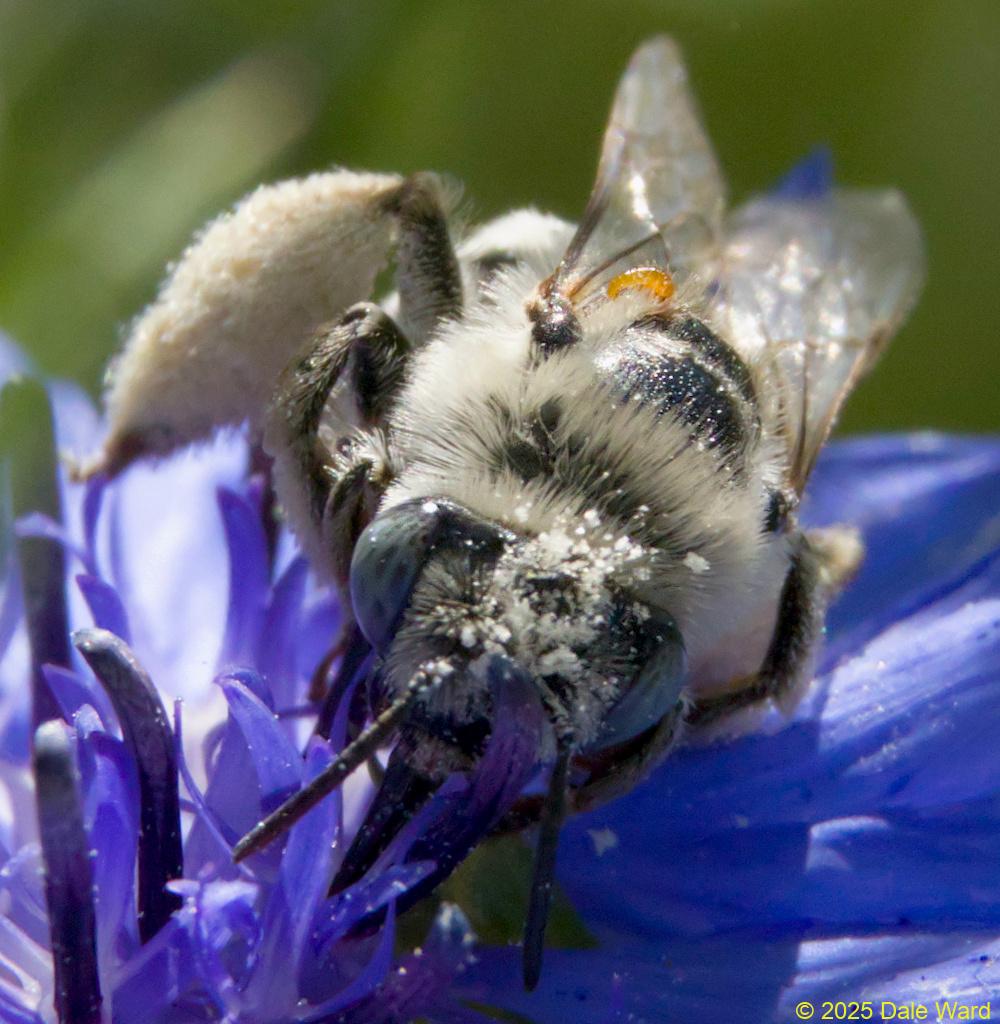 Blister Beetle triungulin larva on Melissodes sp. bee. It’s the small orange-colored object on the bee’s back.
Blister Beetle triungulin larva on Melissodes sp. bee. It’s the small orange-colored object on the bee’s back.
In the Summer of 2024, I spent a few days watching and photographing native bees in Southwestern Colorado. Recently, as I was reviewing the images, I noticed something that I hadn’t seen when I was taking the photos.
One of the Melissodes bees had a small orange-brown larva crawling on her thorax.
Ah! This was a larval Blister Beetle - a triungulin! I had finally found one!
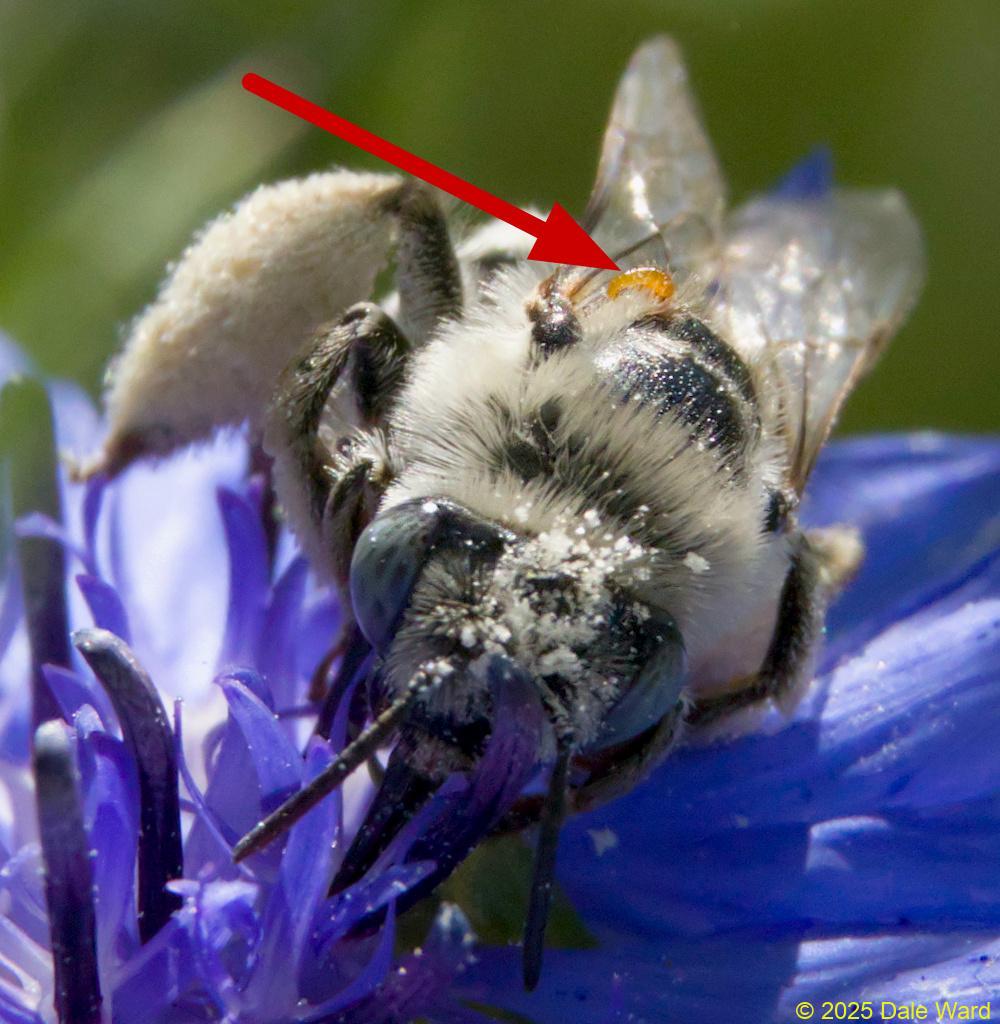 Blister Beetle triungulin larva on Melissodes sp. bee - see red arrow!
Blister Beetle triungulin larva on Melissodes sp. bee - see red arrow!
First-instar Blister Beetle larvae are very, very different than their subsequent larval stages. They have legs and antennae and they clamber about, hunting for a host. They are quite active and aware of the world. There’s a special name for a larva of this type a “triungulin” (plural “triungula”).
In this case, the triungulin had found a female bee. It had climbed onto the bee, and was hoping to hitch a ride to the bee’s nest.
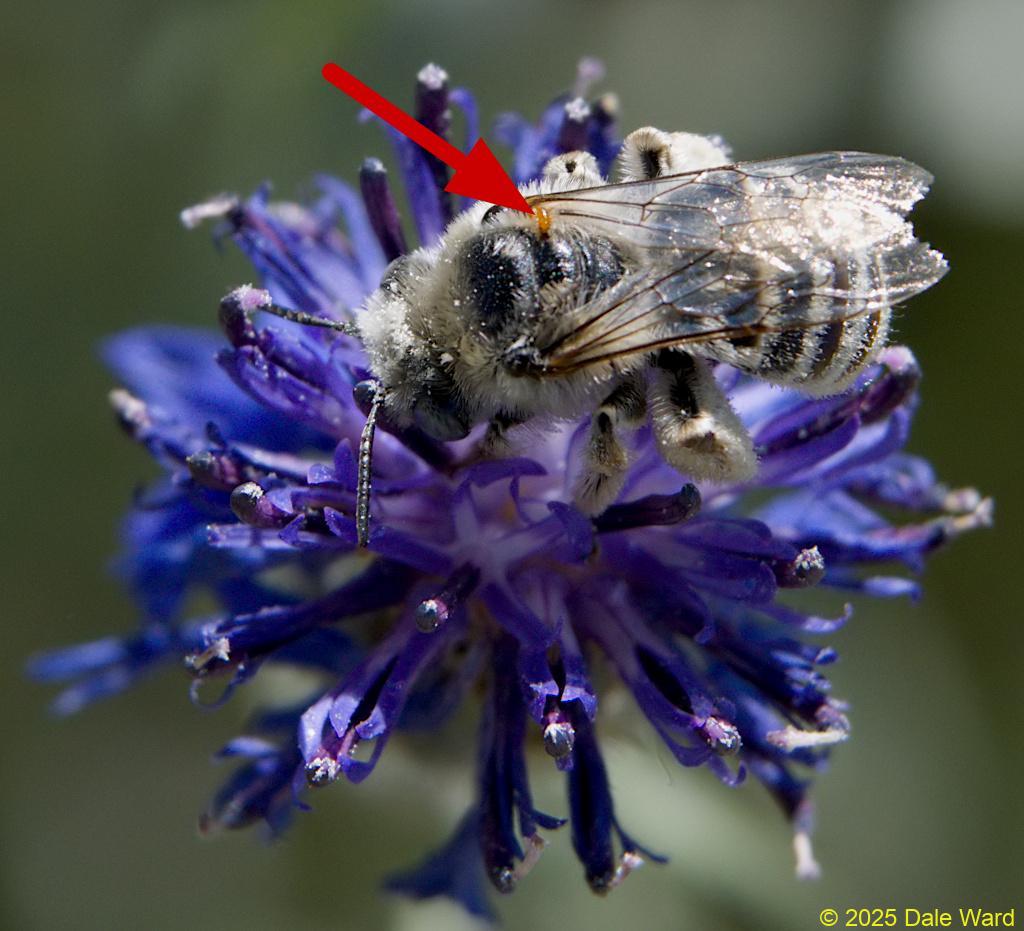 Melissodes sp. Bee with a Blister Beetle triungulin larva, indicated by the red arrow.
Melissodes sp. Bee with a Blister Beetle triungulin larva, indicated by the red arrow.
Once the female bee inadvertently carries the triungula back to her nest, the triungula leave her and go to her offspring. The triungula molt into less mobile, grub-like forms. These sedentary larvae are more optimized for eating and growing, not moving and hunting. They feast on the bee’s larvae, as well as the food the bee has gathered and stored for her larvae.
The differences between the first-instar triungula and the grub-like second- and third-instar larvae are so great that they could easily be mistaken for entirely different organisms. It’s as though there were an extra stage added onto the beetle’s life cycle. The magnitude of change is such that entomologists have a special term for it: “hypermetamorphosis”.
When I think of triungula, I think of the face-hugger in the ‘Alien’ movie. Like a triungulin, the face-hugger larva hatches from an egg, then actively hunts for a host. When the movie’s face-hugger catches a host, it molts into an ‘eating and growing’ chest-burster form that lives inside the host. The chest-burster grows then “exits the host”. After that, it molts into the adult alien form. Cinematic hypermetamorphosis!
I’ve written about some of the astonishing aspects of Blister Beetles and their life cycles here and here. I’ve also written about Rhipiphorid Beetles, another beetle family that has triungulin larvae. But when I wrote those posts I only had photos of the the adult beetles - none of the triungulin larvae.
Ah, but now! I sat at my desk, staring at the photos and grinning. This was so cool.
After I calmed down, I started going through more of my bee photos.
And I I found another triungulin, on a different type of bee! This one was from late June, also in Southwestern Colorado. It’s on a Leafcutter Bee.
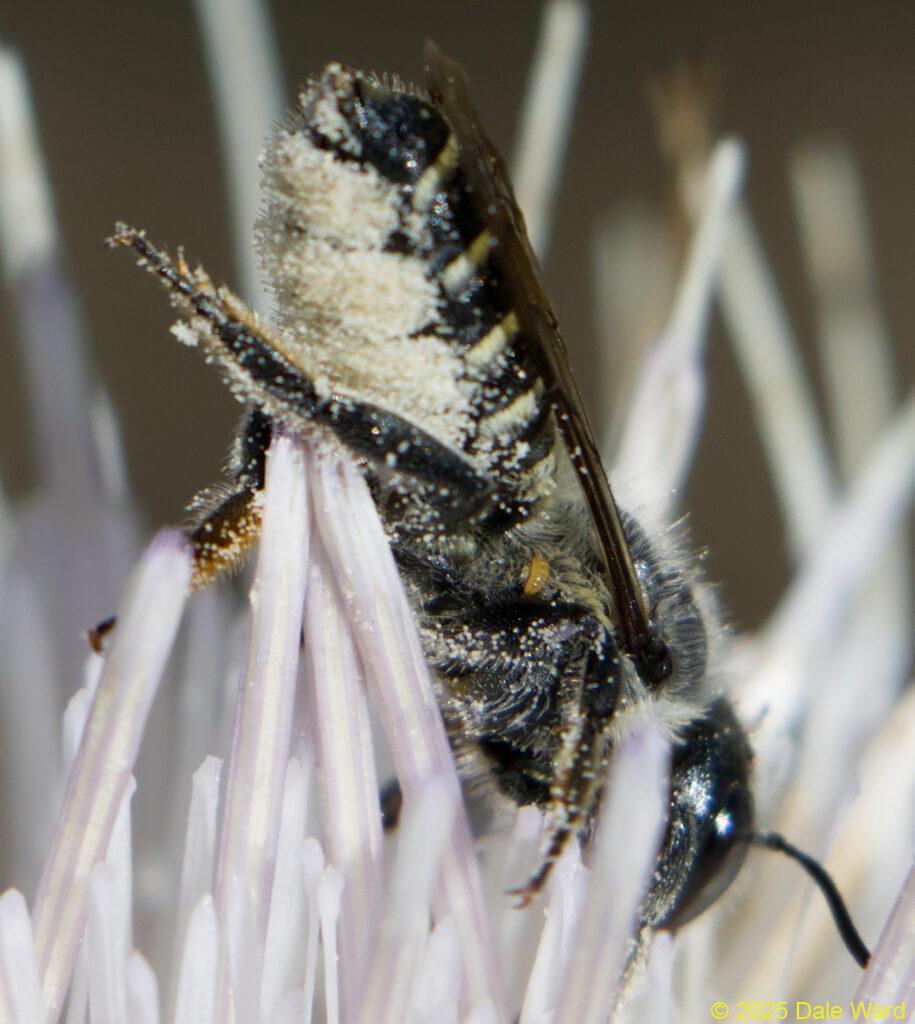 A Leafcutter Bee - in the family Megachilidae. - gathers nectar and pollen on a thistle flower. She carries the white pollen grains on her belly. She’s also carrying a freeloader - a Blister Beetle larva, at the base of her middle leg.
A Leafcutter Bee - in the family Megachilidae. - gathers nectar and pollen on a thistle flower. She carries the white pollen grains on her belly. She’s also carrying a freeloader - a Blister Beetle larva, at the base of her middle leg.
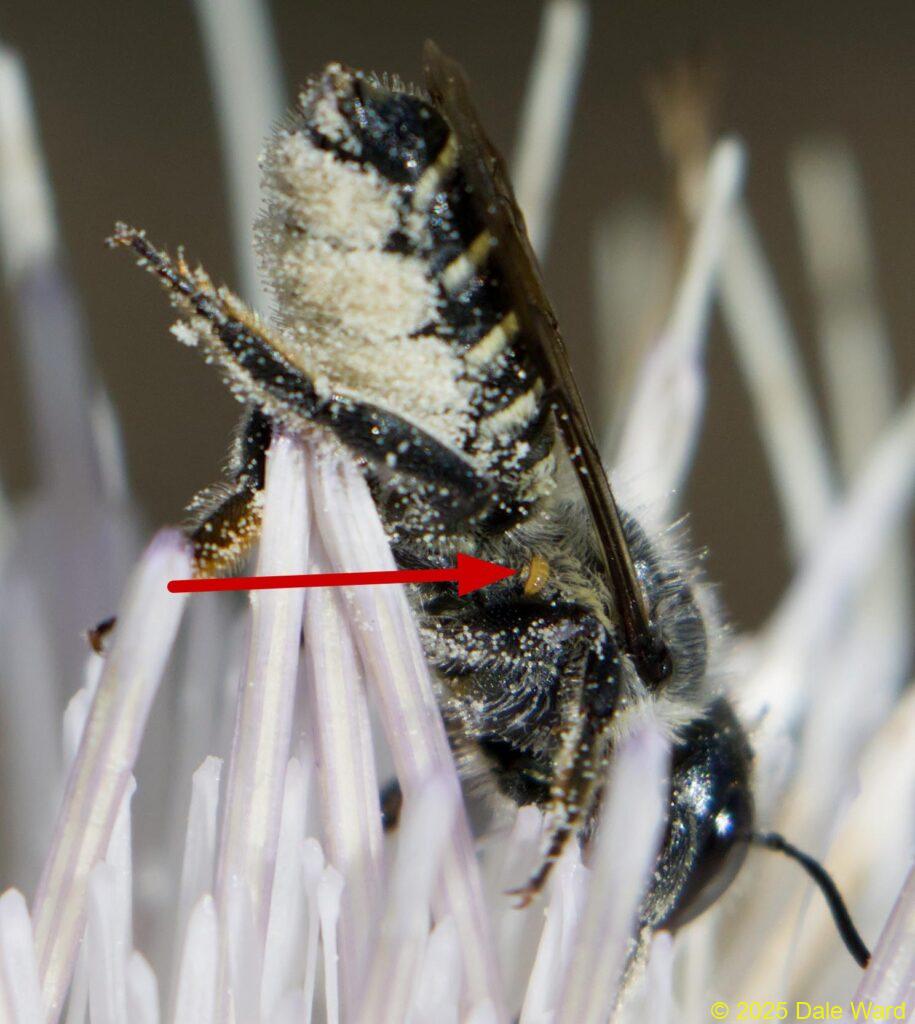 A Leafcutter Bee - in the family Megachilidae, with a Blister Beetle larva, a triungulin, clinging to the base of her middle leg.
A Leafcutter Bee - in the family Megachilidae, with a Blister Beetle larva, a triungulin, clinging to the base of her middle leg.
This Leafcutter Bee is in a different family than the Melissodes bee in the previous photos of this post. So is the triungulin a different species of Meloid Beetle? How host-specific are the Blister Beetles?
I don’t know yet! But I’ll be keeping an eye out in the coming year, for sure.
Addendum:
While researching and writing this post, I came across some fascinating photos on bugguide.net, by the bugguide.net user ‘cotinis’. Those images show a pair of mating Tachinid flies - and the female Tachinid has at least two triungula on her thorax.
Did these triungula climb onto the Tachinid fly by mistake? Are they indiscriminate about whom they climb onto, just hoping that they will eventually be brought into contact with a female bee?
Some genera of Blister Beetles have larvae that prey upon Grasshopper eggs. So not all Blister Beetles are limited to parasitizing bees. Tachinid flies are often parasitoids of other insects…is that relevant in this case? Are these triungula ‘hoping’ to gain access to the Tachinid’s prey? Or was it just happenstance that they are on the female Tachinid?
It’s funny how often the answers to questions ramify into more questions.
Sources:
Carril, Olivia Messinger and Joseph S. Wilson. 2023. Common Bees of Western North America (Princeton Field Guides). Princeton University Press, May 23, 2023. ISBN 0691175500.
Eisner, Thomas and Edward O. Wilson. 2003. For Love of Insects. Belknap Press, First Edition (November 30, 2003). ISBN 0674011813.
Eisner, Thomas, Maria Eisner, Melody Siegler. 2007. Secret Weapons: Defenses of Insects, Spiders, Scorpions and Other Many-Legged Creatures. Belknap Press: An Imprint of Harvard University Press (April 30, 2007). 384 pages. ISBN 0674024036.
Evans, Arthur V. 2021. Beetles of Western North America. Princeton University Press (September 28, 2021). ISBN 0691164282.
Marshall, Stephen A. 2018. Beetles: The Natural History and Diversity of Coleoptera. Firefly Books; Illustrated Edition (September 1, 2018). ISBN 0228100690.
Wilson, Joseph S. and Olivia Messinger Carril. 2015. The Bees in your Backyard: A Guide to North America’s Bees. Princeton University Press (November 24, 2015). ISBN 0691160775.
Wikipedia’s entry on Hypermetamorphosis.
Bugguide.net is a wealth of information on all of these creatures, and refer to them constantly. One special mention to the Bugguide.net’s user ‘cotinis’ for his fascinating photos of triungula on Tachinid flies, here: https://bugguide.net/node/view/1783939
A special thanks to the members of the Facebook ‘Hymenopterists Forum’ for help with the identification of the bees and triungulin larvae. They are a fine, fine group, of people. Also note that any errors on this page are mine, probably brought about by my misunderstandings!